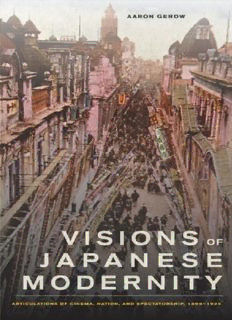
Visions of Japanese Modernity: Articulations of Cinema, Nation, and Spectatorship, 1895-1925 PDF
Preview Visions of Japanese Modernity: Articulations of Cinema, Nation, and Spectatorship, 1895-1925
The publisher gratefully acknowledges the generous support of the Ahmanson Foundation Humanities Endowment Fund of the University of California Press Foundation. Published with the assistance of the Frederick W. Hilles Publication Fund of Yale University. Visions of Japanese Modernity Articulations of Cinema, Nation, and Spectatorship, 1895–1925 AARON GEROW University of California Press BERKELEY LOS ANGELES LONDON University of California Press, one of the most distinguished university presses in the United States, enriches lives around the world by advancing scholarship in the humanities, social sciences, and natural sciences. Its activities are supported by the UC Press Foundation and by philanthropic contributions from individuals and institutions. For more information, visit www.ucpress.edu. University of California Press Berkeley and Los Angeles, California University of California Press, Ltd. London, England © 2010 by The Regents of the University of California Library of Congress Cataloging-in-Publication Data Gerow, Aaron Andrew. Visions of Japanese modernity : articulations of cinema, nation, and spectatorship, 1895–1925 / Aaron Gerow. p. cm. Includes bibliographical references and index. ISBN 978-0-520-25672-9 (cloth : alk. paper) ISBN 978-0-520-25456-5 (pbk. : alk. paper) 1. Motion pictures—Japan—History—19th century. 2. Motion pictures— Japan—History—20th century. I. Title. PN1993.5.J3G45 2010 791.430952’09041—dc22 2009030995 Manufactured in the United States of America 19 18 17 16 15 14 13 12 11 10 10 9 8 7 6 5 4 3 2 1 This book is printed on Cascades Enviro 100, a 100% post consumer waste, recycled, de-inked fiber. FSC recycled certified and processed chlorine free. It is acid free, Ecologo certified, and manufactured by BioGas energy. energy. To my parents Contents List of Illustrations Acknowledgments Introduction 1. The Motion Pictures as a Problem 2. Gonda Yasunosuke and the Promise of Film Study 3. Studying the Pure Film 4. The Subject of the Text: Benshi, Authors, and Industry 5. Managing the Internal Conclusion: Mixture, Hegemony, and Resistance Notes Selected Bibliography Index Illustrations 1. Kaeriyama Norimasa’s Sei no kagayaki (The Glow of Life) 2. The debonair criminal mastermind and master of disguise, Zigomar 3. Asakusa’s moving picture district in 1910 4. Katsud shashinkai, a high-class magazine that spoke in defense of the motion pictures 5. A postcard still of Kabuki actors Ichikawa Danj r IX and Onoe Kikugor V performing Momijigari 6. The smithy in Gor Masamune k shiden (The Story of the Filial Child Gor Masamune) 7. An ad for the Chiyodakan theater featuring a combination of Kabuki cinema, foreign pictures, and modern ad design 8. The young reformers Kaeriyama Norimasa and Shigeno Yukiyoshi at Kinema Record 9. Tanaka Eiz ’s Ikeru shikabane (The Living Corpse) 10. Movie fans at a film event put on by the reformist cinema journal Katsud no sekai 11. An article in English printed in Kinema Record, April 1915 12. Theater manager Sat Tar and lead benshi Mori k at the Taiy kan theater in Nagoya 13. Eda Fushiki in 1915, when he was a benshi at the Denkikan 14. The benshi Nishimura Rakuten in 1917 15. Tokugawa Musei later in life (circa 1930s), when he was a prominent film actor, essayist, and radio raconteur 16. The Nikkatsu ky geki film star Onoe Matsunosuke 17. Edna Mayo on the cover of the April 1916 Kinema Record 18. Pola Negri on the cover of the August 1, 1924, Kinema junp 19. The shack that was the Nikkatsu Kansai studio in 1915 20. Advertisement for the Ushigomekan, which presented itself as a high-class theater for a new age 21. Advertisement for the Konparukan, in Tokyo’s Ginza area 22. The Teikokukan picture palace
Description: